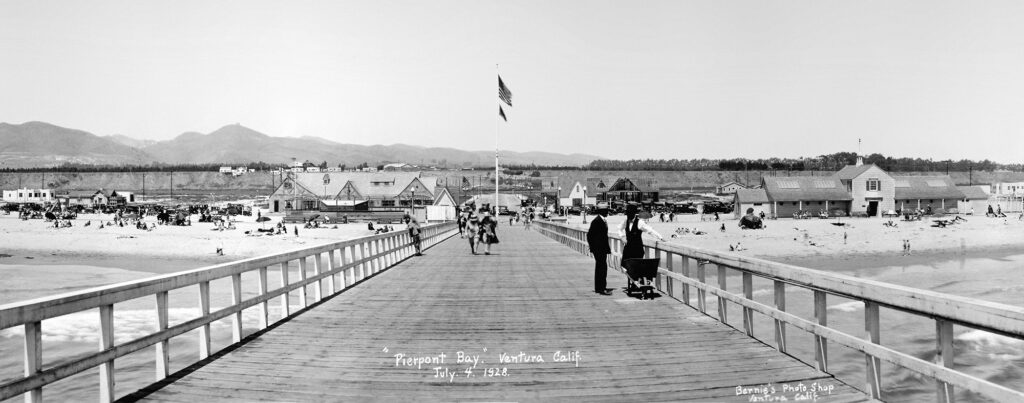One hundred years ago, it was 1924. Southern California was a magical place.
Hollywood was booming; open space, citrus farms, and new roads led to new communities. Los Angeles grew its roots into the nearby beach towns of Venice Beach, Long Beach, and Santa Monica. California was iconic.
Frank Meline who was an American real estate developer and architect, saw an opportunity in a little oil town named San Buenaventura. In 1924, The Frank Meline Co partnered up with a group of prominent Ventura County citizens, including Adolfo Camarillo and Jos. D. McGrath, to purchase a two-mile stretch of land along the beach. The property was bought for $300,000. Frank Meline was to develop and sell parcels. His vision was to make the area into a vibrant and stylish community with a casino, bathhouse, swimming pool, dance hall and Hotel.
Camping in Pierpont Bay, early 1920’s.
The Pierpont Bay community had clear urban planning guidelines. The commercial district of the development included a Bath House, Hotel, and Pleasure Pier, which are to be located centrally within the house lots. The subdivided lots were organized by courts and small lanes as a secondary street between each row of lots. Shore Drive ran along the ocean behind the first row of houses. The Lanes and Courts all have English-sounding names, reflecting the influence of English architecture and design in the community. Gloucester Court, Plymouth Court, and Rockaway Court, to name a few. The lanes remain the same. A few original houses remain. The current back door and the backyard are the original front side of the home, as the design was to face the “courtside” of the streets!
But what will the community’s name be? In 1925, the Frank Meline Co. conducted a contest to name the new tract. He was very focused on involving the community in the development of the new community. Two winners were awarded $100 each for their submission, “Pierpont Bay,” equivalent to about $1,700 now.
The lots came with design guidelines for English cottage-style homes. Architectural plans for every building proposed to be erected at Pierpont Bay must first be submitted to an art jury whose chief function was to ensure consistency in the architecture and design. The community also had restrictions on what could be built. The deed restrictions state that no saloon, foundry, brickyard, cemetery, reform school, fish cannery, or slaughterhouse could do business there.
“The first impression of a visitor to Pierpont Bay is its quiet restfulness and charm. A leading landscape architect, internationally famous, describes Pierpont Bay, with its backeround of rolling hills and the intriguing pananorama of the Santa Cruz Island in front as a scene of “melting lovelinese.”
-1926 Ventura County Star newspaper advertisment
Photograph of exterior of house under construction, Pierpont Bay, Ventura 1926.
Photograph of interior of house under construction, Pierpont Bay, Ventura 1926.
Photograph of exterior of house under construction, Pierpont Bay, Ventura, 1926.
Photograph of the construction of a house on the sand, Pierpont Bay, Ventura 1926.
By 1927, work was in full effect, putting in roads, building a pleasure pier, and paving Shore Drive along the beach. At the time, coastal communities were centered around entertainment and beachgoing, with boardwalks and a Pleasure Pier. Pleasure Piers first emerged in England in the 19th century, carrying travelers from the shore to steamers out at sea. Over time, Pleasure Piers evolved into an entertainment mecca from grand pavilions and theatres to amusement rides, music, and restaurants in the 20th century. Piers were the place to see and be seen at the seaside.
Photograph of the Pierpont Bay Boardwalk with “Pierpont Bay”, on the flag.
Photograph of children at Pierpont Bay, Ventura, 1926.
Richard George Stobs (left) and Edward E. Mosher (right) standing in front of a bait shop on the Pierpont Pier.
The stock market crash of 1929 changed the course of development in Pierpont Beach. The events and beach activities resumed. Rumor is that you had to get to the beach shortly after sunup to ensure a spot! Along the boardwalk were taverns, trinket stores, candied apples, five-cent hot dogs, events, and parties. Every big celebration was centered around Pierpont Pier. 4th of July parties, bathing beauty contests, and clubs. Despite the fun, sales and building slowed. Lots struggled to sell, and homes halted construction.
On a Saturday night, six years later, the tides were high, and the Winter surf took charge. The Pierpont Bay pier, bathhouse, boardwalk, and Shore Drive were destroyed beyond repair after two consecutive storms in 1936. The bathhouse was torn down in 1937. Houses built along the oceanfront were moved away from the oceanfront one by one.
These storms effectively stopped all development in Pierpont until the mid-50s, a period that marked a time of freshness and new life to Pierpont Bay. As time went on we learned more about the ebb and flow of the sand and power of our winter storms. The remaining empty lots from the 1920’s were sold and developed, ushering in a new era of architectural diversity. Today, the area is an eclectic mix of mid-century beach shacks and more modern custom homes.
Shore Drive, Pleasure Pier, and the boardwalk are memories beneath the dunes.
-Shannon Kenny, 2024

